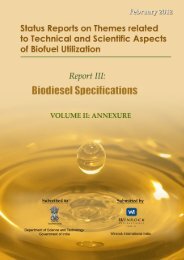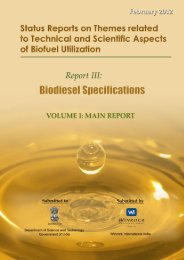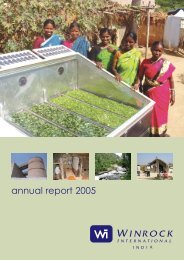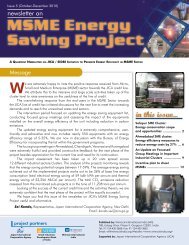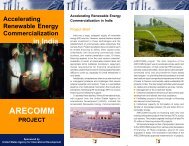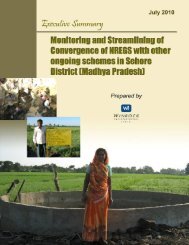IssuE 8 â ApRIl â JuNE 2011 - Winrock International India
IssuE 8 â ApRIl â JuNE 2011 - Winrock International India
IssuE 8 â ApRIl â JuNE 2011 - Winrock International India
You also want an ePaper? Increase the reach of your titles
YUMPU automatically turns print PDFs into web optimized ePapers that Google loves.
Policy perspective<br />
Thailand’s Biomass Policy – A View from<br />
<strong>India</strong>n Policy Perspective<br />
Biomass is one of the most<br />
important sources of renewable<br />
energy in <strong>India</strong> and Thailand.<br />
Energy from biomass in rural areas<br />
through direct combustion has<br />
been the most important process in<br />
converting biomass to other useful<br />
forms of energy. In Thailand, the<br />
industries that rely on biomass as an<br />
energy source are brick production,<br />
tobacco, and lime production,<br />
smoking of rubber sheet and fish mill<br />
production. Wood fuels, including<br />
charcoal, are the most prominent<br />
biomass energy sources. Substantial<br />
uses of biomass energy in developing<br />
countries continue to be in rural and<br />
traditional sectors of the economy.<br />
Most biomass is not traded, but<br />
is homegrown or collected by<br />
households.<br />
Rice farming is the largest sector of<br />
agriculture in Thailand. Rice husk is a<br />
by-product of paddy mill. In Thailand,<br />
rice husk contributes about 4.6 million<br />
tons a year, 23% of the total rice<br />
production. Instead of being dumped<br />
as waste, rice husk has been used as<br />
fertilizer, chicken and duck farm’s<br />
litter, fuel source for manufacturing<br />
processes such as brick and charcoal<br />
making. The main problem for rice<br />
mill owners is to decide on how<br />
to utilize the full potential of total<br />
amount of rice husk available to them.<br />
Biomass is a principle energy source<br />
and contributes a third of <strong>India</strong>'s<br />
energy. Technologies like biogas and<br />
improved cook-stoves exist in <strong>India</strong><br />
since half a century. Policy makers<br />
perceived biomass as an energy<br />
alternative that could alleviate energy<br />
crisis. The biomass strategy focused<br />
on improving efficiency of traditional<br />
technologies, enhancing supply of<br />
biomass by introducing modern<br />
biomass technologies to provide<br />
reliable energy services at competitive<br />
prices and establishing institutional<br />
support. The DNES, established in<br />
1982, implemented the improved<br />
cook stoves program with moderate<br />
success. Programs such as fuel<br />
wood plantation and biomass based<br />
electricity generation have begun<br />
recently. There is a growing experience<br />
of managing biomass projects. In 1992,<br />
up gradation of DNES to MNES has<br />
accorded a higher status to renewable<br />
energy technology programs. Ministry<br />
of Non-Conventional Energy Sources<br />
(MNES) was renamed as Ministry<br />
of New and Renewable Energy<br />
(MNRE) in 2006. The role of new and<br />
renewable energy has been assuming<br />
increasing significance in recent<br />
times with the growing concern for<br />
the country’s energy security. New<br />
policies aim to promote modernization<br />
and commercialization of biomass<br />
production, combustion, densification,<br />
and electricity generation. A long term<br />
techno-economic analysis using the<br />
MARKAL model shows that biomass<br />
electricity technologies have significant<br />
potential to penetrate <strong>India</strong>n market<br />
under a fair competition with fossil<br />
technologies. Under an optimal<br />
greenhouse gas mitigation regime,<br />
biomass electricity penetration can<br />
reach 35 gigawatt in 2035.<br />
Evolution and Growth of<br />
Biomass Policy in Thailand<br />
The Thai government has enforced<br />
an energy policy to promote use<br />
of biomass as fuel for generating<br />
electricity through SPPs (Small Power<br />
Producers) and VSPPs (Very Small<br />
Power Producers) program. Under<br />
which rice husk and rice husk mixed<br />
with other biomass-based power<br />
generation plants increased to 35<br />
plants in 2006 with total capacity of<br />
about 574 MW [3]. The amount of<br />
rice husk which is used as fuel for<br />
generating electricity is approximately<br />
6 million tons per year (9,800 tons<br />
per MW per year). At the beginning<br />
of policy enforcement, rice husk<br />
was among the first choices due to<br />
its low price, small size, and low<br />
moisture, compared to palm oil<br />
residue. Moreover, rice-husk ash has<br />
good quality and it can be sold to<br />
material industries if its combustion<br />
is well controlled. Effect of this policy<br />
appeared in rice-husk collection<br />
process. In the past, price of rice husk<br />
was reported to be in the range of<br />
50 - 150 baht per ton (US$1.25-3.75<br />
per ton) but nowadays, price in some<br />
areas have jumped suddenly and<br />
has reached around 1,000 baht per<br />
ton (US$25 per ton).The high price of<br />
rice husk occurred in some areas due<br />
to limitation of amount of rice husk.<br />
Investigation of economic viability<br />
shows that current price is maximum<br />
value at which rice-husk-based power<br />
generation plant can get profit by<br />
selling electric power to the grid. On<br />
the other hand rice husk in some area<br />
is not used effectively has low price<br />
and is often disposed. The price of<br />
rice husk depends on its location of<br />
production.<br />
Since the Thai government has a<br />
policy that encourages private sector<br />
April-June <strong>2011</strong><br />
27




